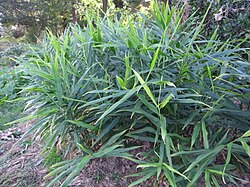Ginger
| Zingiber officinale subsp. var. | Ginger, Common ginger, Stem ginger, Canton ginger | |||||||||||||||||||||||||||||||||||||||||||||||||||||||
|---|---|---|---|---|---|---|---|---|---|---|---|---|---|---|---|---|---|---|---|---|---|---|---|---|---|---|---|---|---|---|---|---|---|---|---|---|---|---|---|---|---|---|---|---|---|---|---|---|---|---|---|---|---|---|---|---|

|
|
| ||||||||||||||||||||||||||||||||||||||||||||||||||||||
| ||||||||||||||||||||||||||||||||||||||||||||||||||||||||
| Standard Cyclopedia of Horticulture |
|---|
|
Zingiber officinale, Roscoe. Ginger. Sts. normally more than 3 ft. high from a tuberous rhizome: lvs. sessile, lanceolate or linear-lanceolate, attenuate-acuminate at base, up to 8 in. long and scarcely 3/4 in. broad: spikes ellipsoidal, obtuse, dense, 2 in. long; bracts ovate, pale green, margins often yellow: calyx crenate; corolla yellowish green, lobes lanceolate, acute, lip oblong-ovate, purple, yellow-spotted, lateral lobes ovate, acute. Native of Trop. Asia, but cult. throughout the tropics and intro. into S. Fla.
|
Zingiber officinale is grown for the spicy aromatic root, popular in cooking and as medicine, as well as for aesthetic reasons in warm climes. Leaves are glossy green and narrow. Small green inflorescences have white and pink-maroon buds and yellow flowers. Plant comes in various forms. Most forms sterile.
- More information about this species can be found on the genus page.
Cultivation
Propagation
Pests and diseases
Similar species
- Myoga (Zingiber mioga Roscoe) - flower buds are used in Japanese cuisine
- galangal (Boesenbergia rotunda, aka Thai ginger, fingerroot, Chinese ginger or krachai) also in the ginger family is used in Thai cuisine. Galangal is also called Thai ginger.
- Asarum canadense, a native species of eastern North America, is also known as "wild ginger", but should not be eaten!
Gallery
-
Ginger root
-
Ginger section
-
Ginger field
-
Sketch of ginger plant
References
- Standard Cyclopedia of Horticulture, by L. H. Bailey, MacMillan Co., 1963
- Flora: The Gardener's Bible, by Sean Hogan. Global Book Publishing, 2003. ISBN 0881925381
External links
- w:Ginger. Some of the material on this page may be from Wikipedia, under the Creative Commons license.
- Ginger QR Code (Size 50, 100, 200, 500)




